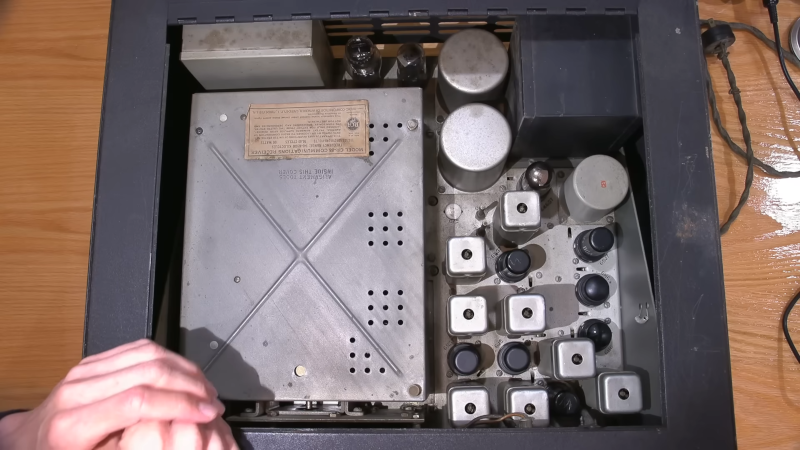The RCA CR-88 was a radio receiver made to work in top-secret government eavesdropping stations. As you might expect, these radios are top-of-the-line, performance-wise, at least when they are working correctly. [Mr. Carlson] has one on his bench, and we get to watch the show on his recent video that you can see below.
Interestingly, [Mr. Carlson] uses some Sherlock Holmes-like deductive reasoning to guess some things about the radio’s secret history. The radio’s design is decidedly heavy-duty, with a giant power transformer and many tubes, IF transformers, and large filter capacitors.
The underside of the radio reveals neat wiring and some big metal shields. The metal shields and filters have a very specific purpose. The radio was probably in a bank of radios, and you don’t want them interfering with each other. In addition, you might not want someone tracking your super secret listening post by its RF emission. [Mr. Carlson] shows on the schematic how the designers reduced unwanted emissions from the radio.
The end of the video shows the radio turning on and receiving something for some frequencies, but it had some problems. We suspect he’ll be fixing and aligning the whole thing in a future video.

















What was the difference between the cr88 and ar88 ?
https://www.radioblvd.com/ar88.htm
“In late-1945, RCA replaced the AR-88 with the CR-88 which placed the Crystal Phasing control on the front panel and reduced the size of the RF Gain and AF Gain control knobs so all three controls would fit just below the tuning dial.”
Nice, like R390 levels of nice. Take care of that ol’ girl!
When I was a child in the early 50’s our household radio was an AR88. I was told it had come out of a plane.
I wonder if we will see 80s or 90s listening post gear any time soon? I imagine it is all Flex style rackmount sdr today?
It’s a spy radio in “Mr Carlsen’s” imagination.
Yes, it likely did receive transmissions from spies. But I’m sure it saw other uses. In a couple ofthe James Bond films, we see a room of Racal receivers. But that doesn’t make them spy receivers. R390s or maybe R388s, were on the US Pueblo when it was captured in 1968 by the North Koreans. There was an article in QST some years later where the radioman told of taking axes to the receivers. But while they were used for spying, they weren’t “spy radios”.
Keep the term for tiny radios taken by spies to enemy territory.
I don’t know how it differs, but in 1972 I saw an AR-88 in a science museum in Ottawa. Visitors coukd use it. Hardly a secret radio.
What you’ve said is supported here: https://www.radiomuseum.org/r/rca_cr_88.html. It seems to have been a commercial radio built to military specs and used by the Navy, but it wasn’t exclusive to the military.
Yeah, right? I was going to go with “radio used by the US military for clandestine eavesdropping stations”, in the headline, but it didn’t fit.
You’ll note that Al is very precise in his writeup. I’m to blame for “spy” in the title. Hope it didn’t make you want to un-watch the video.
I googled and there are a couple of photos of the AR-88 being used in the UK during the war for SOE and signals intelligence. Yeah, the spy thing is overblown in the video, but they were actually used on the home side of the spy game and also to intercept German signals. Apparently they were Lend-Leased by the hundreds, then destroyed per agreement after the war.
Actually, good quality shortwave radios were purchased by spies to receive numbers stations. For example, you wouldn’t consider a Zenith 1000-D a “spy” radio but spies apparently bought them when smuggling in a (probably inferior) receiver from the east would not be possible .
https://www.cryptomuseum.com/spy/zenith/1000/index.htm
Zenith Trans-Oceanics…
Cool piece of gear and nice video, but a bit much elaboration on how not too scratch your work bench for my taste
So it won’t fit on my wrist or in the heel of my shoe.
If you are that worried about scratching the work bench then:
It ain’t a “work” bench! HA!!
That’s a nice receiver, for sure.
But THIS is a spy radio:
https://www.paraset.nl/aa/
A Paraset is on my bucket-list to build.
The CR-88 is great receiver, I have had several of them. An even greater receiver is the CR-91. It is very similar and from a distance the look the same. However, the CR-91 covers beside the short wave bands up to 32Mhz, it also covers the VLF bands from 70 Khz to about a Mhz, then skips part of the BC band and begins again at about 2Mhz. I doubt the CR-88 or the 91 ever saw wartime service like the AR-88 (which by the way did not have a crystal filter) The 88’s and 91’s were designed around 1945 , they were used exclusively by RCA in their overseas telecommunications networks and many were also used by Bell telephone in their overseas networks. Yes they are very heavy (about 90-100lbs) and well made. All the CR-88’s and 91’s were made in Canada by RCA of Canada. Why? Who knows.